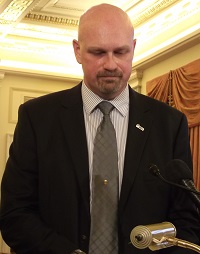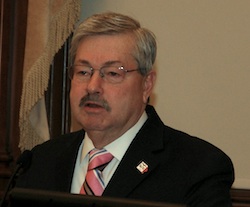 QBotix, a company that delivers up to 20% improvements in solar PV project economics with the optimized Robotic Tracking System, has announced $12 million in Series B financing. E.ON and Iberdrola joined existing investors, New Enterprise Associates, Firelake Capital Management and Draper Nexus, in the funding round.
QBotix, a company that delivers up to 20% improvements in solar PV project economics with the optimized Robotic Tracking System, has announced $12 million in Series B financing. E.ON and Iberdrola joined existing investors, New Enterprise Associates, Firelake Capital Management and Draper Nexus, in the funding round.- A new poll, funded by the Alliance for Solar Choice, finds that eight out of ten Mainers (82%) oppose adding a charge on customers that generate their own electricity with rooftop solar or other technologies. Poll results indicate general opposition for a standby charge, which has been proposed Central Maine Power (CMP) and would require customers to pay an extra fee for being connected to the grid, even when that customer is using the electricity that they generated themselves.
- The National Small Business Defense Contracting Summit is scheduled for August 18-19, 2014 at USAF Hurlburt Field in Ft. Walton Beach, Florida. This major national conference is produced by the Defense Leadership Forum, in partnership with U.S. Congressman Jeff Miller (FL-1) and U.S. Congressman Steve Southerland (FL-2). The Summit will provide information to small businesses on how to bid for defense contracting opportunities the the U.S. Department of Defense including the U.S. Air Force, Navy, Army and Marines along with military bases and the Pentagon. Contracts may include biofuels and bioenergy (such as solar, distributed generation, etc.) making the Summit a great resource for the alternative energy industry.
- Juice Bar® EV, a provider of premium electric vehicle (EV) charging stations has partnered with Macquarie Equipment Finance (MEF) to make the process of acquiring a charging station easier and more affordable for facility owners. The Juice Bar EV provides owners a customizable opportunity to create income-producing assets with Juice Bar charging stations. Owners have the choice in customizing their Juice Bar to fit the needs of their facility, including the ability to partner with sponsors and advertisers to offset the cost, and the choice in charging a fee or not charging a fee to the consumer.
Wind Leads Renewable Energy Increase in Texas
 Oil-rich Texas is seeing a surge in renewable energy use, and that surge is being led by wind. This article from the Dallas Business Journal says an Electric Reliability Council of Texas report shows wind, solar and other renewable energy sources increased 12 percent last year, with wind making up the lion’s share of that increase.
Oil-rich Texas is seeing a surge in renewable energy use, and that surge is being led by wind. This article from the Dallas Business Journal says an Electric Reliability Council of Texas report shows wind, solar and other renewable energy sources increased 12 percent last year, with wind making up the lion’s share of that increase.
Renewable energy produced 38.1 million megawatt hours of power in 2013 compared to just 33.9 million MWh in 2013. Wind power makes up 97 percent of the renewable generation. Wind generation grew by more than 4 million MWh , or 13 percent, in 2013 as well.
Solar grew by 33 percent, or 40,000 MWh, in 2013. Landfill gas had a modest increase, too.
The article goes on to say that biomass and hydroelectric actually went down in 2013.
Students’ Biodiesel Wins Environmental Award
A project by a group of Tennessee high school students to make and promote biodiesel garnered an environmental award in that state. The Whites Creek High School group is the winner in the Excellence in Energy and Renewable Resources category of the 2014 Governor’s Environmental Stewardship Awards, which this article in the Chattanoogan says recognizes exceptional voluntary actions that improve or protect our environment and natural resources with projects or initiatives not required by law or regulation.
 Students from Whites Creek High School recently drove across Tennessee on fuel that they made from agriculture product, soybeans. They were able to achieve this by using 15 bushels of donated soybeans and converting them into biodiesel in their energy laboratory at the high school. They were able to extract 12 gallons of biodiesel from their process which allowed them to drive across Tennessee from Kentucky to Alabama in a Ford F250 farm truck. Along the route, they traveled to other high schools and the students taught other FFA members the mechanics of biodiesel production with their mobile lab. Whites Creek High School has a three-year program called Academy of Alternative Energy, Sustainability and Logistics. During the three year program, they study wind energy, solar energy, biodiesel, ethanol, the hydrogen car, nuclear energy, greenhouse gas, and have hands on experience on the adjacent farm to the high school.
Students from Whites Creek High School recently drove across Tennessee on fuel that they made from agriculture product, soybeans. They were able to achieve this by using 15 bushels of donated soybeans and converting them into biodiesel in their energy laboratory at the high school. They were able to extract 12 gallons of biodiesel from their process which allowed them to drive across Tennessee from Kentucky to Alabama in a Ford F250 farm truck. Along the route, they traveled to other high schools and the students taught other FFA members the mechanics of biodiesel production with their mobile lab. Whites Creek High School has a three-year program called Academy of Alternative Energy, Sustainability and Logistics. During the three year program, they study wind energy, solar energy, biodiesel, ethanol, the hydrogen car, nuclear energy, greenhouse gas, and have hands on experience on the adjacent farm to the high school.
The awards will be handed out in ceremony to be held in Nashville on June 23.
Biodiesel Producer Certain Uncertainty Will End
 The manager of a biodiesel refinery from the Nation’s largest biodiesel producer believes the uncertainty in the green fuel’s future will disappear. I caught up with Bryan Christjansen, a general manager for Renewable Energy Group’s Albert Lea, Minn. and Mason City, Iowa plants, shortly after a news conference where several biodiesel producers joined with a group of U.S. senators to decry the uncertainty brought by the government’s proposal to lower the amount of biodiesel to be mixed into the fuel supply and Congress’ failure to renew the $1-a-gallon federal biodiesel tax incentive.
The manager of a biodiesel refinery from the Nation’s largest biodiesel producer believes the uncertainty in the green fuel’s future will disappear. I caught up with Bryan Christjansen, a general manager for Renewable Energy Group’s Albert Lea, Minn. and Mason City, Iowa plants, shortly after a news conference where several biodiesel producers joined with a group of U.S. senators to decry the uncertainty brought by the government’s proposal to lower the amount of biodiesel to be mixed into the fuel supply and Congress’ failure to renew the $1-a-gallon federal biodiesel tax incentive.
“Some of the things happening here on Capitol Hill, as well as in the White House, are not good for our industry. We are here, and [Congress and the Administration] have helped us get to this point, and we need to continue to grow this industry through what you guys have created already,” he said.
While Bryan said that the current Environmental Protection Agency (EPA) proposal on the Renewable Fuels Standard is hurting the biodiesel industry by causing so much uncertainty, he is certain that will change.
“With this [news] conference and the open comment period with the EPA, I think we’ve voiced our opinion that we need to reduce our dependence on foreign oil, and what better way to do it than by producing biodiesel.”
You can hear my conversation with Bryan here: Bryan Christjansen, REG manager
And you can hear what he and other producers said here: Biodiesel Industry Concerns And what the U.S. senators attending the news conference said here: Senators Voice Biodiesel Concerns
Biodiesel Adds Value, Diversification to Ethanol Ops
 It’s not a brand new idea, but the concept of co-locating ethanol and biodiesel plants has been catching on more and more lately. This article from Biodiesel Magazine talks about how ethanol refiners are looking to take their by-product, distillers corn oil (DCO), and turn it into biodiesel to add value to those ethanol plants already on the ground, while diversifying their operations.
It’s not a brand new idea, but the concept of co-locating ethanol and biodiesel plants has been catching on more and more lately. This article from Biodiesel Magazine talks about how ethanol refiners are looking to take their by-product, distillers corn oil (DCO), and turn it into biodiesel to add value to those ethanol plants already on the ground, while diversifying their operations.
“Over the past several years, biodiesel margins have been really strong,” says Ray Baker, general manager for Adkins Energy LLC, a 50 MMgy ethanol refinery in Lena, Ill. Adkins Energy announced last fall that it has contracted with WB Services to install a 2 MMgy biodiesel facility on-site with help from a $500,000 grant from USDA’s Rural Energy for America Program. “But one of the reasons I think we really like the project and the idea behind it,” Baker says, “is that we are already producing a conventional biofuel—corn-based ethanol—and we’ll now be producing an advanced biofuel in biodiesel, and I know in the future we’ll have the opportunity to be producing cellulosic ethanol. So we look at all aspects of the RFS and the growth that’s really built into that, and we see those opportunities.”
In recent years, DCO has emerged as one of the fastest-growing biodiesel feedstocks, and the technologies to effectively convert DCO to biodiesel have been improving. “I think once they got to that point, that helped the technology evolve and the idea behind it become more economical to install into a plant,” he says. “Before, the size of biodiesel plants was much larger, and now I think bolting them onto ethanol technologies on a smaller scale has become economical.”
The article goes on to talk about how better integration of the two fuels’ technologies is making these co-located plants more feasible. In addition, new technologies for brewing biodiesel, especially enzymatic technologies in the pretreatment of the corn oil and replacing the usual biodiesel catalyst methanol with the already available ethanol, are making biodiesel-ethanol operations more likely.
Iowa Gov Says Biofuels Cure for Climate Change
 As members of a federal task force visit Iowa and say that “climate change is here and now,” that state’s governor says biofuels, which are also here and now, are at least one way to fight the changes in climate. This article in the Waterloo Cedar Falls Courier says this is the third meeting of the White House task force and comes on the heels of the recent Obama Administration’s National Climate Assessment that says climate change could bring disastrous results for agricultural areas, such as Iowa, “including prolonged periods of heat, heavy downpours, and in some regions, floods and droughts.” Branstad makes the case that if the government followed the law on the Renewable Fuels Standard (RFS), many of these issues would be dealt with.
As members of a federal task force visit Iowa and say that “climate change is here and now,” that state’s governor says biofuels, which are also here and now, are at least one way to fight the changes in climate. This article in the Waterloo Cedar Falls Courier says this is the third meeting of the White House task force and comes on the heels of the recent Obama Administration’s National Climate Assessment that says climate change could bring disastrous results for agricultural areas, such as Iowa, “including prolonged periods of heat, heavy downpours, and in some regions, floods and droughts.” Branstad makes the case that if the government followed the law on the Renewable Fuels Standard (RFS), many of these issues would be dealt with.
“Climate change is here and now,” said Mike Boots, acting chairman of the White House Council on Environmental Quality.
He ran down a list of some of the effects of climate change being experienced in the Midwest, such as poorer crop yields because of heat and torrential rains that overfill river banks and wash away topsoil.
Iowa Gov. Terry Branstad did not attend the event as he was traveling the state for a series of community tours, Branstad spokesman Jimmy Centers wrote in an e-mail.
“Gov. Branstad believes that as government officials travel to Des Moines they should focus on reducing transportation emissions and our dependence on overseas oil, diversifying our nation’s energy portfolio and supporting the growth of the Midwest economy through a strengthened Renewable Fuel Standard,” Centers wrote.
White House officials say the RFS was not discussed during the symposium. Recently, the U.S. Environmental Protection Agency recommended reducing the amount of ethanol and biodiesel to be mixed into the Nation’s fuel supply. Farm-state governors, such as Branstad, have blasted the agency for that recommendation and hope to get it reversed before it is due to be finalized within about a month.
Power Your Electronics with Wind
Most of us have heard about or already own chargers powered by solar energy to charge cell phones, iPads, laptops and more. But did you know that you can now charge all your electronics with wind energy? Skajaquoda has launched its latest version of the Trinity portable wind turbine – small enough to fit in your purse or briefcase yet powerful enough to charge your electronics.
 The Trinity 100 has a 100W generator and a built-in battery that holds 30,000mAh. The mini wind turbine folds together into a 20 inch cylinder that can easily be carried anywhere. Trinity 100 weighs only 6 lbs and 5 lbs without the removable internal battery. On the bottom, Trinity 100 has a 110V output with EU/UK/US wall plug/adapter to charge your devices. It also has a 5V 1A USB and 5V 2.1A USB outputs and an input to charge Trinity’s internal battery in a wall socket.
The Trinity 100 has a 100W generator and a built-in battery that holds 30,000mAh. The mini wind turbine folds together into a 20 inch cylinder that can easily be carried anywhere. Trinity 100 weighs only 6 lbs and 5 lbs without the removable internal battery. On the bottom, Trinity 100 has a 110V output with EU/UK/US wall plug/adapter to charge your devices. It also has a 5V 1A USB and 5V 2.1A USB outputs and an input to charge Trinity’s internal battery in a wall socket.
Trinity’s smaller version has a 15W generator and a 15,000 mAh internal battery that can charge USB devices and laptops. The whole unit weighs only 2.5 lbs and 2 lbs without the removable internal battery.
To operate, you simply open the three blades, remove the aluminum legs and arrange them in either a tripod configuration or laid flat. To close the mini wind turbine, you push the legs back in and the blades close automatically. In a closed position the legs lock the blades and prevent them from opening.
Trinity’s unique design allows you to charge your smartphone up to 10-12 times before it has to be recharged either by itself (using the wind) or simply plug it into a wall output so it can be fully charged before you leave your home. I’ll use the wind, please and thank you.
Halco Energy Deploys Propane Trucks
Phelps, New York – based Halco Energy is deploying 25 vehicles powered by propane autogas in their service and installation fleet. The company provides residential and commercial renewable energy solutions including high-efficiency heating and cooling systems; home energy audits; and envelope improvements including insulation, air-sealing, and clean renewable energy systems. And now the company is “walking the walk” with its fleet conversion to propane autogas.
The company is now sporting 16 Ford E-350 cargo vans and 9 Ford F-250 pickup trucks equipped with ROUSH CleanTech propane autogas fuel systems. The conversions were funded, in part, by a $200,000 grant from the Genesee Region Clean Communities. The domestically fueled vehicles will help the company drive down fuel and maintenance expenses by an estimated $600,000 and reduce their carbon footprint by more than 1.6 million pounds over thee lifetime of the vehicles.
 “We’re in the renewable energy business so doing the right thing for the environment is very important to us,” said Hal Smith, co-owner of Halco Energy. “We were looking for a fuel that’s cleaner, better for environment and less costly. With propane autogas, we are optimistic that we’ve found a great solution to meet these needs.”
“We’re in the renewable energy business so doing the right thing for the environment is very important to us,” said Hal Smith, co-owner of Halco Energy. “We were looking for a fuel that’s cleaner, better for environment and less costly. With propane autogas, we are optimistic that we’ve found a great solution to meet these needs.”
Halco Energy is working to install a 16,000-gallon on-site fueling station but in the meantime they will fuel the vehicles at a local public station. According to ROUSH CleanTech, the infrastructure for propane autogas is less expensive than any other alternative fuel, and with thousands of stations across the nation, propane autogas already has the largest public refueling infrastructure of all alternative transportation fuel options.
“Energy efficiency is our life, so for us, propane autogas, has been a no-brainer,” said Smith. “By deploying propane autogas vehicles in our fleet, we’re helping our pocketbook and the environment at the same time. I just wonder why more companies aren’t doing the same thing.”
A 2013 recipient of the national “Home Performance with Energy Star” award, Halco Energy aims to transition 75 percent of their total fleet to propane autogas over the next four years.
Another Day, Another Oil Spill
An oil pipeline ruptured in Los Angeles on LA Street yesterday and in response Americans United For Change said, “Like oil spills? You’ll love what happens after dismantling the Renewable Fuel Standard. 50,000 gallons of crude oil spilled out onto the streets and in some areas the crude oil was knee-high.
Jeremy Funk, spokesperson for pro renewable energy and pro Renewable Fuel Standard (RFS) group Americans United for Change, said of the crude oil spill, “Whether you live in the Gulf Coast community, near a railroad in Lynchburg, VA, a farm in North Dakota, or in the middle of a major metropolis like Los Angeles, it seems nowhere in America is out of reach from the messes big oil leaves behind.”
“Headlines about oil industry spills and explosions and derailments have become a ‘dog bites man’ story,” Funk continued who stressed that the alarming rate of environmental disasters associated with oil should give the Environmental Protection Agency (EPA) serious pause before deciding whether or not to roll back the RFS. The EPA is expected to publish its final 2014 RFS rules around June 1 and there is concern they will move forward with lower renewable fuel gallons than what is called for in legislation.
“Consider that ethanol makes up 10% of the U.S. gasoline supply, and that for every gallon of ethanol produced domestically it means one less gallon sold of gasoline derived from dirty crude oil from unstable regions. That’s why the oil industry wants the EPA to help put out of business their safer, cleaner, cheaper renewable fuels competition. But if the EPA give big oil what they want and drastically cuts down the amount ethanol in the nation’s fuel supply, there’s no way to avoid a corresponding increase in demand for crude oil and an increase in the number of disasters related to transporting it.” Funk added, “So if you like oil spills — you’ll love what happens if the RFS is watered down.”
UCR Unveils Sustainable Grid Initiative
The University of California, Riverside has launched its Sustainable Integrated Grid Initiative to research the integration of intermittent renewable energy including photovoltaic solar panels, energy storage including batteries, and all types of electric and hybrid electric vehicles. The project is the largest of its kind in the state.
California, Riverside has launched its Sustainable Integrated Grid Initiative to research the integration of intermittent renewable energy including photovoltaic solar panels, energy storage including batteries, and all types of electric and hybrid electric vehicles. The project is the largest of its kind in the state.
“This project puts UC Riverside at the forefront of smart grid and electric vehicle research, providing a unique platform for engineers and utilities to identify and solve potential problems at scale,” said Matthew Barth, lead investigator of the initiative and the director of UC Riverside’s Bourns College of Engineering Center for Environmental Research and Technology (CE-CERT).Read More


